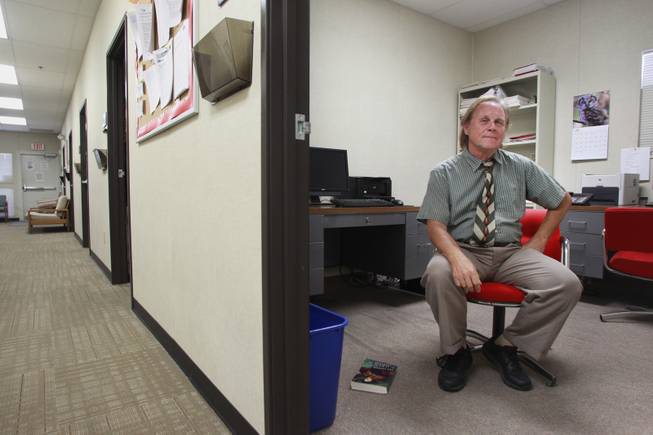
Adjunct English professor Bill Donati is seen in his office Wednesday, June 11, 2014 at UNLV.
Sunday, June 15, 2014 | 2 a.m.
William Donati has a master’s degree from UCLA and a doctorate from UNLV. He makes less than $25,000 a year.
For the past 12 years, Donati has taught English composition and world literature to undergraduate students at UNLV. He typically teaches eight courses a year, reviewing at least 24,000 pages of student papers. Between preparing for class, teaching, grading, holding office hours, attending departmental meetings and writing recommendation letters, Donati estimates he works about 30 hours a week.
For this, UNLV pays him $24,456 a year. That’s about $10,000 less than the average starting salary for a first-year public K-12 schoolteacher in Las Vegas.
“It’s great I have a job, but the pay could be better,” Donati says as he sits in a small trailer office he shares with seven other part-time instructors. “The money is not the best.”
At a growing number of universities nationally, adjunct professors like Donati have become the face of higher education, as colleges increasingly rely on part-time, non-tenure-track faculty for cheap and abundant labor. Last year, nearly 4 out of every 10 professors at UNLV were adjuncts. Nationally, adjuncts constitute a little more than three-quarters of higher education faculty.
While some adjuncts are mid-career or retired professionals who teach because they find the work fulfilling, adjunct positions historically were created to help recent Ph.D. graduates secure temporary positions while seeking tenure-track careers.
About 80 percent of UNLV adjuncts teach part-time for five years or longer, officials said.
“The tenure process is incredibly competitive,” Donati said, pointing to a recent tenure-track position that netted more than 400 applicants. “You have to be brilliant to land a tenured position these days.”
UNLV’s 516 adjuncts work part-time and typically make less than a quarter of what full-time tenure-track and tenured faculty make. An adjunct professor teaching four courses a semester makes $3,057 per course, or $24,456 a year.
Health benefits are included for those who teach at least three courses a semester.
By comparison, UNLV’s tenure-track and tenured professors teach two or three courses a semester and make between $79,000 and $121,000 a year on average, according to the American Association of University Professors’ 2014 faculty survey. Those professors, whose focus is split between teaching and research, receive health benefits year-round.
“We don’t expect parity with full professors, but give us a break,” Donati said. “It would be nice to make what a first-grade teacher in Clark County makes.”
Because of their low pay, many adjuncts at UNLV hold other part-time jobs to make ends meet. Some live with their parents. Nationally, there have been high-profile cases of adjunct professors living on food stamps.
“We understand it’s a pathetically low wage,” said Carl Reiber, UNLV’s vice provost for academic affairs. “But it was never meant to be a living wage.”
UNLV adjuncts teach about a third of all classes and a quarter of all students. Adjuncts are used heavily in liberal arts and constitute about 40 percent of the university’s English department. They teach mostly general education and freshman-level courses and shoulder much of the burden of helping remedial students acclimate to college-level material. About a third of UNLV students require remedial courses.
Adjunct professors who split their time between teaching and part-time work face burnout. And because they don’t have tenure, some adjuncts feel they can’t challenge students and administrators because poor evaluations could hurt their job prospects.
Nationally, some adjuncts who feel exploited have begun to organize, fighting for unionization, a living wage, better working conditions and support.
UNLV officials have begun to take notice. As the economy improves, administrators are trying to reduce their reliance on adjunct professors and increase pay for them. UNLV cut its budget for part-time instructors from about $12.1 million in 2007 to roughly $9.1 million in 2010. And the university is looking at ways to boost adjunct pay from $923 per credit hour to $1,130 per credit hour.
UNLV administrators also are trying to convert more of their adjunct faculty into full-time lecturers, who make a starting salary of $40,000 a year with benefits. While the “faculty-in-residence” positions are not tenure-track, they are eligible for promotions after six years.
In UNLV’s liberal arts college, which has the most adjuncts, 26 adjuncts have been converted to faculty-in-residence or full-time lecturers over the past two years.
“We value teaching tremendously,” Reiber said. “What we want is full-time faculty as the face of the university.”
For adjunct professors like Donati, the changes cannot come soon enough. As the university considers investing in new research initiatives, a new medical school and new football stadium, UNLV adjuncts say they hope they aren’t left behind.
“I love teaching,” Donati said. “I like being on campus and the atmosphere of scholarship. But if they can find money for a stadium and new buildings, why can’t they find money for our salaries?”

Join the Discussion:
Check this out for a full explanation of our conversion to the LiveFyre commenting system and instructions on how to sign up for an account.
Full comments policy